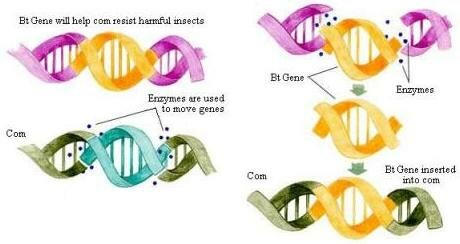Benefits of Genetic Engineering
Genetic engineering facilitates the manipulation and duplication of DNA pieces, for industrial, medical and research purposes. Genetic engineering has produced a revolution in molecular biology. Benefits of Genetic Engineering are experienced in whole array of fields especially in agriculture, in production of valuable proteins and vaccine production. The benefits of genetic engineering is a common topic in biology classes. For students struggling with this subject, we recommend seeking assistance from Essay Tigers.

Pic Credit : Link
Benefits of Genetic Engineering in Agriculture
The production of technologies based on genetic engineering is often referred as modern biotechnology. With the improvement of genetic engineering techniques, the time for generating and evaluating new germplasm (a collection of genetic resources for an organism) can be drastically reduced. Genetic engineering may ultimately have their most significant effect on agriculture. Recent advances have raised possibility of development of new plant germplasm through introduction of any gene from any organism into plant.
With respect to agriculture, modern biotechnology has been considered as the second phase of green revolution. Organisms whose genes have been altered by manipulation are called genetically modified organism (GMO). The working of GMO is due to nature of transferred genes, nature of host organism and food web formed. Some useful benefits of genetically modified plants in agricultural biotechnology are:
- Improved nutritional quality
- Better Nitrogen Fixation
- Disease resistant Plant
- Enhanced efficiency of minerals used by plants to prevent early exhaustion of fertility of soil.
- Reduced post harvest losses
The first genetically modified food was Flavr Savr Tomato which was resistant to rotting.

Pic Credit : Link
Another genetically modified food is golden rice (Pro Vitamin A enriched). Several other genetically modified foods include, soybeans, corn, cotton, seed oil etc have been formed. But many controversies are associated with genetically modified food including environment and human safety, ethics, food security, poverty reduction etc.
Some success has been achieved in developing varieties resistant to herbicides, viral diseases and insect pest. Genetic engineering promises rapid acceleration of plant breeding efforts for crop improvement.
Benefits of genetic engineering: Production of valuable Proteins
Another benefit of genetic engineering is realized in production of valuable proteins. Recombinant DNA made possible the use of bacteria to produce proteins of medical importance. One such example is that of genetically engineered human insulin which is of great importance and now marketed throughout the world.
Some important genetically engineered proteins include:
Human Insulin
Human insulin or Humulin has great importance. Earlier, patients could not tolerate pig insulin, as it has slightly different amino acid sequence as compared to human. Humulin eventually became cheaper than that extracted from animal pancreas and is now available.
Interferon
Interferon is an antiviral agent which is secreted by cells which are attacked by virus. Several types of genetically engineered interferon are available in market and gives rise to antitumoral effect (thwarting formation of cancerous tumors).
Growth hormone
In humans, growth hormone helps in treatment of hypopituitary dwarfs. Genetically engineered growth hormones may prove useful in the treatment of bone fractures, skin burns and bleeding ulcers of digestive tract. The human hormone is marketed in United States and bovine hormone is expected to yield bigger cattle and thus more beef. Hence growth hormones are commercially very demanding.
Benefits of genetic engineering: Vaccine production
Vaccines produced by genetic engineering offer an advantage that the microbial strains from which the proteins are extracted do not contain complete viruses. And thus, there are no risks of accidental inoculation with live virus.
Cloning directly into vaccinia virus DNA holds great promise, although vaccines so produced are not yet in the market. Recombinant vaccinia viruses for example, a gene from genital herpes virus within its DNA, can multiply and can subsequently be inoculated into humans. The vaccinia virus produces mild infection, and expresses some of herpes virus protein and produces immunity. This is very similar in a way to what Edward Jenner did over 100 years ago when he introduced the first vaccination scheme, which eventually led to the extinction of smallpox.
Vaccines can be produced using recombinant DNA technology or using cell culture. Vaccines of common use are usually produced by cell cultures or animals. Such vaccines contain weakened or inactivated pathogens. Crop plants can bear cheaper bioreactors to produce antigens to be utilized as Edible vaccines. These edible vaccines are said to be a cheap alternative as compared to recombinant vaccines.
The transgenic plants are treated as edible vaccines and consumption of these transgenic plants viz. transgenic banana and tomato cure diseases like Cholera and Hepatitis-B. Foot and mouth diseases can be cured by feeding them transgenic sugar beet. In the near future, these vaccines can be used as conventional vaccines.
Humulin was the first therapeutic product to be made commercially by genetically engineered bacterium. Recently a genetically engineered malarial vaccine SPF – 66 has been produced.
Benefits of Genetic Engineering: Production of Disease Resistant Plants
Genetic engineering, promises to have an enormous impact on the improvement of crop species. Genetic transformation can boost plant breeding efforts for developing disease resistant varieties. Now the disease resistant genes can be isolated and transferred to high yielding susceptible plants to produce pathogen free plants. Through gene sequencing, it is possible to locate gene and after identification, gene is isolated and transferred to the host. Several disease resistant somaclones have been identified for resistance to severe potato disease, early blight of potato, caused by Alternaria Solani. Scientists are using Agrobacterium gene transfer system to produce tobacco plants with increased resistance to Tobacco Mosaic Virus (TMV).
Insect resistant plants are also developed, using biotechnological applications. Several biopesticides are developed e.g. Bt cotton, Bt corn, rice, tomato, potato, and soybeans etc.

Process of Insertion of Bt gene in corn to make it resistant from insect attack
Pic Credit : Link
Bt signifies Bacillus thuringiences. This bacterium contains insect toxin gene. Bt toxin gene is cloned from the bacteria and expressed in plant to provide resistance from insects, without requirement of insecticides. These modified disease resistant plants are called transgenic plants.
